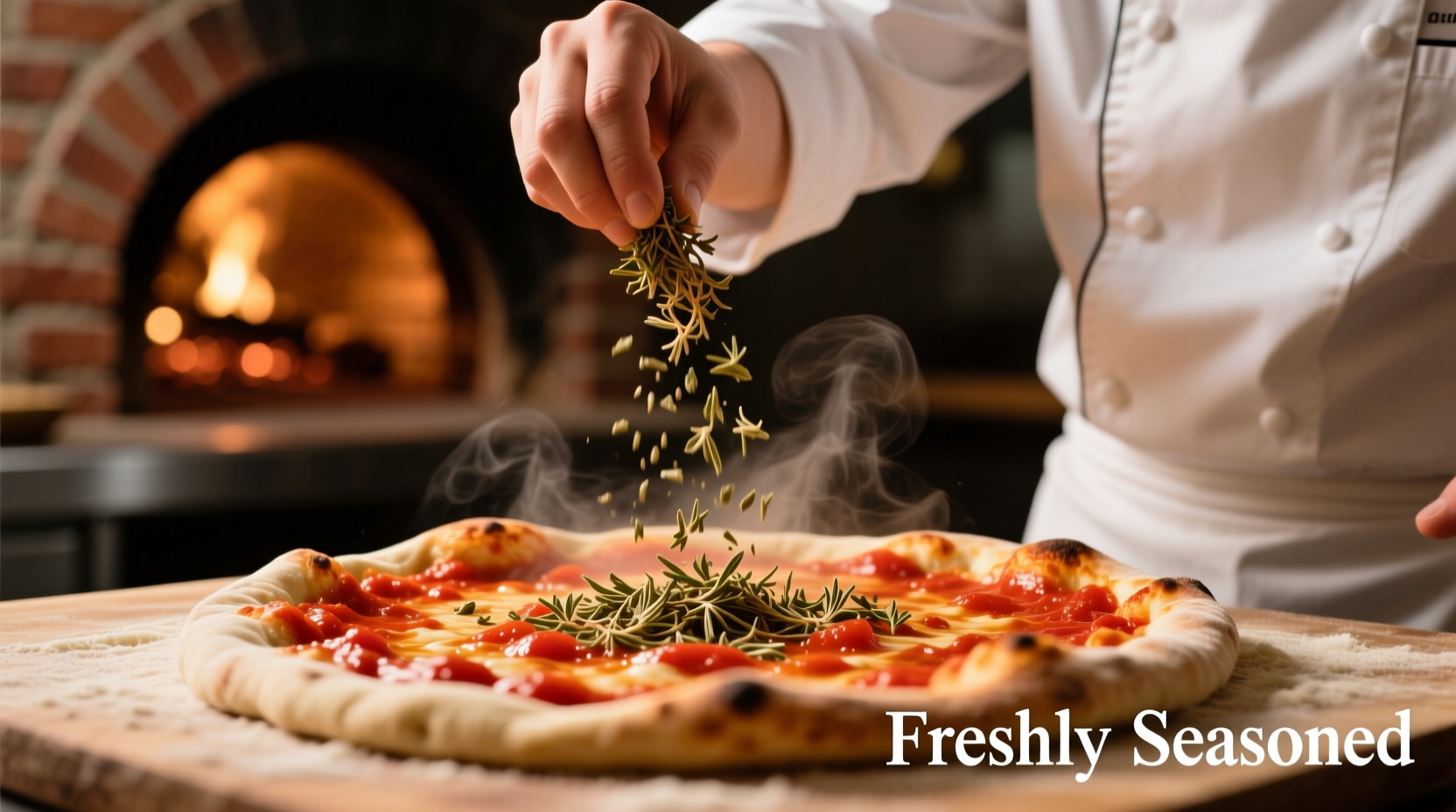When crafting the perfect pizza, spices make the difference between ordinary and extraordinary. This guide reveals exactly which spices work best, when to apply them, and how to create balanced flavor profiles that elevate your pizza from basic to brilliant—whether you're using store-bought dough or making from scratch.
The Science Behind Pizza Spice Pairing
Pizza's unique flavor profile—acidic tomato sauce, rich cheese, and varied toppings—creates specific opportunities for spice enhancement. Understanding how spices interact with these components helps you make informed choices rather than random guesses.
Food science research from the Culinary Institute of America shows that volatile compounds in dried herbs like oregano bind effectively with fats in cheese and olive oil, creating flavor compounds that survive baking temperatures. Fresh herbs added after baking provide aromatic top notes that dried spices can't replicate.
| Spice | Best Applied | Flavor Contribution | Ideal Pizza Type |
|---|---|---|---|
| Dried oregano | With sauce before baking | Earthy, slightly bitter | All tomato-based pizzas |
| Fresh basil | After baking | Sweet, herbal, aromatic | Margherita, vegetable pizzas |
| Red pepper flakes | Before or after baking | Sharp heat, subtle smokiness | Meat pizzas, spicy variations |
| Fennel seeds | With sausage before baking | Sweet licorice notes | Sausage pizzas |
Essential Pizza Spices: What You Actually Need
Despite endless spice options, professional pizzaiolos rely on just five core spices that consistently deliver authentic results:
Dried Oregano: The Foundation
Authentic Neapolitan pizza uses minimal spices, with dried oregano being the primary choice. According to the True Neapolitan Pizza Association guidelines, high-quality dried oregano contains thymol and carvacrol compounds that enhance tomato's natural sweetness while cutting through cheese richness. Use 1/2 teaspoon per standard pizza, sprinkled over sauce before adding cheese.
Fresh Basil: The Finishing Touch
Add fresh basil leaves after baking for aromatic complexity. The volatile oils in fresh basil (linalool and eugenol) evaporate quickly at high temperatures, making post-bake application essential. Tear leaves by hand rather than cutting to prevent bruising and bitter flavors.
Garlic: The Flavor Bridge
Garlic powder works better than fresh garlic for most pizza applications. When fresh garlic bakes, it can become bitter, while garlic powder distributes evenly and caramelizes beautifully. Use 1/4 teaspoon per pizza mixed into the sauce. For gourmet variations, infuse olive oil with garlic cloves and drizzle after baking.
Red Pepper Flakes: Controlled Heat
Quality red pepper flakes contain both seeds and fruit for balanced heat. The Scoville rating of typical pizza flakes ranges from 5,000-15,000 units—enough to provide warmth without overwhelming. Add before baking for integrated heat, or after for sharper spice notes. Start with 1/8 teaspoon per pizza and adjust to preference.
Black Pepper: The Secret Weapon
Often overlooked, freshly ground black pepper adds complexity to cheese-forward pizzas. The piperine in black pepper enhances umami perception in melted cheese. Apply after baking for maximum aromatic impact.

Advanced Spice Applications for Creative Pizzas
Once you've mastered the basics, these professional techniques can elevate your pizza to restaurant quality:
Spice Timing Techniques
The timing of spice application dramatically affects flavor development:
- Pre-bake application: Dried spices mixed into sauce or sprinkled on cheese before baking meld with other ingredients
- Post-bake application: Fresh herbs and delicate spices added after baking provide bright top notes
- Double application: Using both dried oregano before baking and fresh basil after creates layered flavor
Regional Spice Traditions Timeline
Pizza spice usage has evolved significantly over time:
- 1889: Queen Margherita's namesake pizza featured only tomatoes, mozzarella, and fresh basil—no dried spices
- Early 1900s: Italian immigrants in America began using dried oregano, which wasn't common in Naples
- 1940s-1950s: Post-WWII spice availability led to red pepper flakes becoming standard in American pizzerias
- 1980s-present: Regional variations emerged with fennel in sausage pizzas and garlic in white pizzas
When NOT to Use Certain Spices: Critical Boundaries
Professional chefs recognize specific limitations for pizza spices:
- Curry powder: Overpowers delicate cheese flavors except on specialty chicken curry pizzas
- Cinnamon: Creates unpleasant chemical reactions with tomato acid in most applications
- Dried basil: Loses complex flavor compounds when baked, resulting in flat, medicinal notes
- Pre-mixed Italian seasoning: Often contains marjoram and thyme that compete with oregano's signature pizza flavor
Practical Application Guide
Follow these steps for perfectly seasoned pizza every time:
- Prepare your sauce: Mix 1/2 teaspoon dried oregano and 1/4 teaspoon garlic powder per cup of sauce
- Apply to crust: For white pizzas without tomato sauce, brush crust with garlic-infused oil before adding cheese
- Add during assembly: Sprinkle red pepper flakes between cheese and toppings for integrated heat
- Finish after baking: Add fresh basil, a pinch of flaky sea salt, and black pepper immediately after removal from oven
- Rest before serving: Allow pizza to rest 2-3 minutes for flavors to settle and spices to integrate
Common Spice Mistakes Home Cooks Make
Avoid these frequent errors that ruin otherwise good pizza:
- Over-spicing: More than 1 teaspoon total dried spices per standard pizza creates imbalance
- Using old spices: Dried herbs lose 50% of flavor compounds after 6 months—store in airtight containers away from light
- Mixing fresh and dried versions: Using both dried and fresh basil creates muddy, indistinct flavor
- Applying spices directly to raw dough: Without sauce or oil as a medium, spices burn during baking
Specialty Pizza Spice Pairings
Tailor your spice selection to specific pizza styles:
Sausage Pizza
Add 1/4 teaspoon crushed fennel seeds to the sauce—fennel's anethole compounds complement pork fat beautifully. For spicy sausage, reduce red pepper flakes to avoid overwhelming heat.
Vegetable Pizza
Use herbes de Provence sparingly (1/4 teaspoon) for earthy complexity. Add after baking for roasted vegetable pizzas to preserve delicate herbal notes.
White Pizza
Nutmeg is the secret weapon—just a pinch (1/16 teaspoon) enhances cheese flavor without detectable nutmeg taste. Garlic powder and black pepper complete the profile.
Storing and Preparing Spices for Maximum Impact
Proper spice handling makes a significant difference in pizza flavor:
- Toasting dried spices: Briefly toast oregano in a dry pan before use to release essential oils (10-15 seconds on medium heat)
- Crushing by hand: Rub dried oregano between palms to break cell walls and release flavor compounds
- Storage: Keep dried spices in dark glass containers away from stove heat—kitchen cabinets beat refrigerator storage for spice preservation
- Fresh herb preservation: Store basil stems in water at room temperature (never refrigerate) to maintain flavor











 浙公网安备
33010002000092号
浙公网安备
33010002000092号 浙B2-20120091-4
浙B2-20120091-4